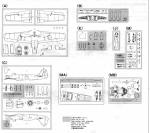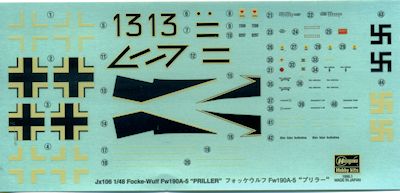
Hasegawa 1/48 FW-190A-5 'Priller'
| KIT #: | 09206 (Jx106) |
| PRICE: | $6.00 on the sales table |
| DECALS: | Two options |
| REVIEWER: | Scott Van Aken |
| NOTES: | Reboxed Dragon kit. 1996 boxing |

| HISTORY |
The Fw 190 A-5 was developed after it was determined that the Fw 190 could easily carry more ordnance. The D-2 engine was moved forward another 15 cm (6 in) as had been tried out earlier on the service test A-3/U1 aircraft, moving the center of gravity forward to allow more weight to be carried aft. Some A-5s were tested with the MW 50 installation: this was a mix of 50% methyl alcohol and 50% water, which could be injected into the engine to produce a short-term power boost to 2,000 PS (1,973 hp, 1,471 kW), but this system was not adopted for serial production. New radio gear, including FuG 25a Erstling IFF, and an electric artificial horizon found their way into the A-5. The A-5 retained the same basic armament as the A-4.
The A-5 too, saw several Umrüst-Bausätze kits. The U2 was designed as a night Jabo-Rei and featured anti-reflective fittings and exhaust flame dampeners. A centre-line ETC 501 rack typically held a 250 kg (550 lb) bomb, and wing-mounted racks mounted 300 L drop tanks. A EK16 gun camera, as well as landing lights, were fitted to the wing leading edge. The U2 was armed with only two 20 mm MG 151 cannon. The U3 was a Jabo fighter fitted with ETC 501s for drop tanks and bombs; it too featured only two MG 151s for armament. The U4 was a "recon" fighter with two RB 12.5 cameras and all armament of the basic A-5 with the exception of the MG FF cannon. The A-5/U8 was another Jabo-Rei outfitted with SC-250 centreline-mounted bombs, under-wing 300-litre drop tanks and only two MG 151s; it later became the Fw 190 G-2. A special U12 was created for bomber attack, outfitted with the standard 7.92 mm (.312 in) MG 17 and 20 mm MG 151 but replacing the outer wing 20 mm MG-FF cannon with two underwing gun pods containing two 20 mm MG 151/20 each, for a total of two machine guns and six cannon. The A-5/U12 was the prototype installation of what was known as the R1 package from the A-6 onwards. The A-5/R11 was a night fighter conversion fitted with FuG 217 Neptun (Neptune) radar equipment with arrays of three dipole antenna elements vertically mounted fore and aft of the cockpit and above and below the wings. Flame-dampening boxes were fitted over the exhaust exits. 1,752 A-5s were built from November 1942 to June 1943.
| THE KIT |
 This is one of Hasegawa's reboxings, and it is of the
first properly done FW-190 in 1/48, the Trimaster/Dragon kit. This is the Dragon
version as it does not have the metal landing gear of the Trimaster kit. It
still has the photo etch and you get two frets of the stuff in this one. It is
mostly used for interior bits like the armored head rest, seat harness,
instrument panel, and side consoles. In fact, there is no plastic instrument
panel or head rest so you have to use p.e.
This is one of Hasegawa's reboxings, and it is of the
first properly done FW-190 in 1/48, the Trimaster/Dragon kit. This is the Dragon
version as it does not have the metal landing gear of the Trimaster kit. It
still has the photo etch and you get two frets of the stuff in this one. It is
mostly used for interior bits like the armored head rest, seat harness,
instrument panel, and side consoles. In fact, there is no plastic instrument
panel or head rest so you have to use p.e.
This is pretty much a standard 'long fuselage' 190 that was used from the A-5 until the A-9 single engine variants. The FW-190D-9 is another subject altogether. This one has the smaller upper cowling as it still uses the smaller cowl guns, but it does have the wing cannon in the outer position so has the appropriate shell ejector chute insert. It also uses the later wheels.
Thanks to the p.e., the cockpit is well done and few will want to replace it with aftermarket. The cowling is a bit complex with four pieces making up the cowling itself and three inserts for the engine exhaust. The A-5 variant is, I believe, the first version that did not offer inner gear doors so has slightly longer main landing gear doors to compensate for that. The prop is one of those deals with separate blades that some of us dislike and they are not keyed. The canopy can be posed open or closed as one wishes.
There are some neat unused options on the sprues for this one including sand filters for the engine and the two twin 20mm gun packs used by some later aircraft. A bomb rack is also included. Not included is any sort of drop tank, which I thought was pretty standard stuff. As often happens when buying 'used' kits, this one was missing the clear bits, but thankfully, a kind reader supplied one.
 Instructions
are typical for Hasegawa with Gunze paint references. The
decal sheet is nicely printed but as you'd expect from 1996, are the old style
where the white is off-white. There are aftermarket for those who may not trust
nearly 20 year old decals. Markings are provided for two aircraft, both in RLM
74/75/76. One is the plane flown by 'Pips' Priller with a yellow rudder and
lower cowlings. Note that the upper surface color is carried into the fuselage
cross. The other option is one flown by Water Oesau when with JG 2. This plane
also has yellow on the rudder and underside of the cowling. Unusually, the plane
has no mottling on the fuselage.
Instructions
are typical for Hasegawa with Gunze paint references. The
decal sheet is nicely printed but as you'd expect from 1996, are the old style
where the white is off-white. There are aftermarket for those who may not trust
nearly 20 year old decals. Markings are provided for two aircraft, both in RLM
74/75/76. One is the plane flown by 'Pips' Priller with a yellow rudder and
lower cowlings. Note that the upper surface color is carried into the fuselage
cross. The other option is one flown by Water Oesau when with JG 2. This plane
also has yellow on the rudder and underside of the cowling. Unusually, the plane
has no mottling on the fuselage.
| CONCLUSIONS |
This particular kit will make into a nice model, but has been eclipsed in terms of ease of construction by newer kits from Hasegawa themselves. However, if you run across one at a good price, then by all means pick it up. It still makes a nice model and will add to your early 190A collection.
| REFERENCES |
http://en.wikipedia.org/wiki/Focke-Wulf_Fw_190
January 2014 Thanks to me for getting this one on sale. If you would like your product reviewed fairly and fairly quickly, please contact the editor or see other details in the
Note to
Contributors.